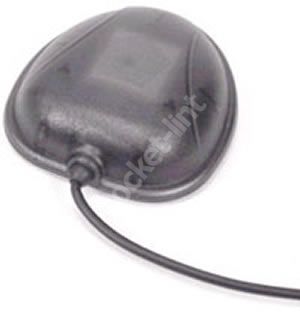GPS navigation is on the rise, and pretty soon, we’ll all be finding it harder to get lost. We took the self-build approach to in-car navigation, pairing the Navman SmartST software, with the Haicom 204S GPS receiver, with an Ipaq 3970. The aim here was to gain in car navigation, using things we already had. Here we focus on the GPS receiver.
Bundled with a suction mount, the power cable for both the Ipaq and the GPS unit, and an additional cable for laptop serial links. The GPS receiver comes with a small manual, a suction cup to hold the cable out of the way, a CD with laptop drivers and manuals. The unit contains a small battery, which stores last position details, making warm-starts even faster. For power, the unit needs the 12v supply in your car. The mini DIN plug on the GPS means that a whole host of power cables are available to match your particular Pocket PC. For the unit to function, it will need to be connected to the power, but not to your PDA. However, you need the PDA to read the NMEA output containing the data.
Out of the box we tried the unit in the car, placed in the centre of the dashboard. Even in this location, it quickly picked up seven satellites, locking on to four to provide 3D mapping through the Smart ST. The unit is magnetic and waterproof, so can be placed on the roof of your car for an even better signal. Of course, this is a wired unit, so you will have to tidy up the cables or live with the mess. Also, the PDA should be placed somewhere that you can see it without taking your eyes off the road - you are approaching a junction, the 3D view in the SmartST software will show you where you are going, even if it hasn’t said where to go.
We did have some problems on our first few attempts, because there is no simple set of instructions with the GPS. You need to make sure that the navigation software is looking in the right place for receiver - for us this meant COM1, at 4800baud. It took some time to find this information. Setting the SmartST software was easy once this was known. That would perhaps be the only criticism of the Haicom GPS unit - the information provided is a bit poor. Written in small writing on the back of the box, it also suggests you keep the unit plugged in for a while to charge the internal battery.
Actual navigation with the SmartST software is good. You can choose which maps to install on to your Ipaq - the 3970 carries an SD slot, so we installed the maps on a 128Mb SD card. This has the advantage of meaning that you don’t need a separate CF jacket, so the unit is less bulky. The downside is that sometimes the Ipaq can’t see the card - removing and reinstalling it usually corrects the problem. SmartST also integrates with your Contacts list, so you can find people by name. It’s a great feature, but you need to ensure that the addresses are complete and correct - we also found that UK wasn’t recognised, with the software preferring England as the country. Changing direction, the GPS was fast to pick up and the software would recalculate your route, or tell you to turn around.
Our quick take
If you’re an Ipaq owner, and fancy getting the most out of it, and want the convenience of in-car navigation system, then it is certainly worth looking into this solution. The Haicom 204S is a great little receiver, with a SIRF II chipset. The literature boasts a cold start of < 48 sec, warm start of < 38 sec, and a hot start of < 8. We paid a price of £65, but you’ll also have to factor in software costs, and the storage card. As far as the GPS receiver goes, it does exactly what it says on the tin - marks lost only because of the supplied literature.

Haicom 204S GPS receiver - 4.0 / 5
| FOR | AGAINST |
|---|---|
|
|
To recap
An excellent cost-efficient GPS solution component
